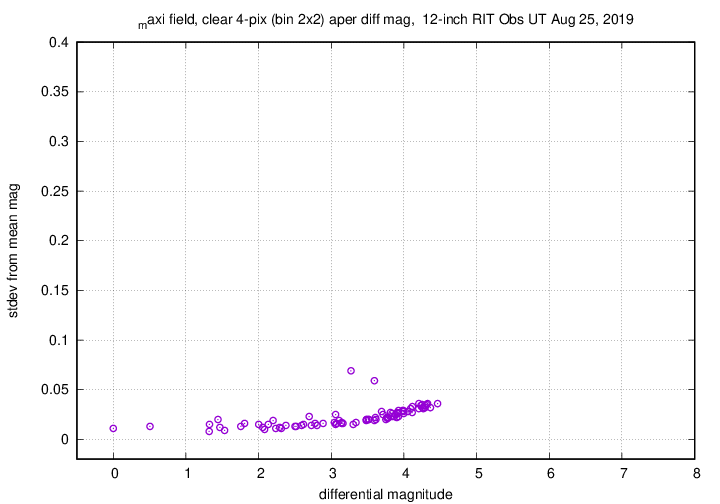On the night of Aug 24/25, 2019, through dark skies, I acquired a set of observations of the likely black-hole system MAXIJ1820+070, (also known as ASASSN-18ey ). It remains at V = 13.9, with considerable variations on short time scales.
This optical and X-ray and radio transient is likely a black hole accreting material at a higher-than-usual rate. It has been the subject of many observers over the past few months -- see the trail of telegrams that include
The main setup was:
Notes from the night:
No problems with hardware or software tonight.
The object is located at
RA = 18:20:21.9 Dec = +07:11:07.3
A chart of the field is shown below. The size of the chart is about 22 by 18 arcminutes.
I've marked the location of several comparison stars, which also appear in light curves below. Stars C, D, and E are mentioned by the Tomoe Gozen team in ATel 11426, but all three are rather red, with (B-V) ranging from 1.14 to 1.37. Star B is one of the bluest nearby bright stars, with (B-V) = 0.52.
star UCAC4 B V ---------------------------------------------------- B 486-079513 12.975 12.454 C 486-079608 13.968 12.830 D 486-079523 14.637 13.272 E 487-077858 14.637 13.272 ----------------------------------------------------
I ran the camera at -20 C. Nothing out of the ordinary.

The sky value shows that the sky was clear, but the Moon rose near the end.

Here's a record of the telescope's drift. For the most part, it tracked well with 5-second exposures; I've kept the X aggressiveness at 0.5.

The number of objects detected.

I used an aperture with radius 4.0 pixels. I changed focus from 0.559 to 0.538 at JD 720.698, due to the drop in temperature, but it seems to have made things slightly worse. So, try to _increase_ focus position when temperature drops.

I discarded images which had obvious trailed stellar images, and also images which were outliers in the "image adjustment" plot. (discarded a total of 39 of the 316 raw images).

Using aperture photometry with a radius of 4 pixels (binned 2x2, each pixel is 1.34 arcsec, so a radius of 5.4 arcsec), I measured the instrumental magnitudes of a number of reference stars and the target. Following the procedures outlined by Kent Honeycutt's article on inhomogeneous ensemble photometry, I used all stars available in each image to define a reference frame, and measured each star against this frame.
Sigma-vs-mag plots show that the floor was about 0.009 mag overall. I did NOT mark star "A" as variable in the ensemble. MAXI is the outlier at ensemble mag of about 3.27.

Here are light curves of the variable and the field stars.

I used the UCAC value for the V-band magnitude of star "B" = UCAC4 486-079513 to shift the ensemble magnitudes to the standard V-band scale.
Here's a closeup on the variable.

You can download my measurements below. A copy of the header of the file is shown to explain the format.
# Measurements of MAXIJ1820+070 made at RIT Obs, UT 2019 Aug 25, # in good conditions, # by Michael Richmond, # using Meade 12-inch LX200 and ATIK 11000. # Exposures 30 seconds long, clear filter. # Tabulated times are midexposure (FITS header time - half exposure length) # and accurate only to +/- 1 second (??). # 'mag' is a differential magnitude based on ensemble photometry # using a circular aperture of radius 4 pix = 5.3 arcseconds. # which has been shifted so UCAC4 486-079513 has mag=12.454 # which is its V-band magnitude according to UCAC4. # # UT_day JD HJD mag uncert Aug25.07086 2458720.57086 2458720.57371 14.142 0.021 Aug25.07137 2458720.57137 2458720.57422 13.888 0.019 Aug25.07186 2458720.57186 2458720.57471 13.963 0.018
Last modified 8/25/2019 by MWR.